
A shade tree can be a Salt Lake City homeowner’s best friend in summer, when temperatures frequently reach 80, 90, or even 100+ degrees. Planting even one large shade tree in your yard can turn it into a haven where you’re protected from the harsh sun while chasing around pets and little ones or maintaining your lawn.
That’s not all shade trees are good for, though. While protecting you from the dry summer heat, shade trees protect your home from the same thing. With shade trees, your home will stay cooler inside, and you’ll spend less money and energy on air conditioning.
Now that you know why you should plant shade trees, it’s time to figure out which tree is best for your yard. We’ll delve into the details of 15 of the best shade trees for Salt Lake City homes.
How to Choose Shade Trees for Your Salt Lake City Home
While you’re shopping for shade trees, keep in mind that not all the options will work for SLC. Narrow your search to trees cold-hardy enough for this area, which falls under USDA Hardiness Zones 5-7.
Think about Salt Lake City’s climate and air quality, too. Trees that need a lot of rainfall or can’t tolerate air pollution probably won’t grow well here.
With those considerations in mind, here are 15 shade trees hand-picked for life in Salt Lake City.
15 Shade Trees for Salt Lake City Yards
1. Bald cypress (Taxodium distichum)

If you’re familiar with the bald cypress, you probably think of it as a southern swamp tree, but think again. Bald cypress trees grow in drier areas like Salt Lake City, too, and they make great shade trees because of their spreading growth.
One possible downside to the bald cypress: It’s a conifer, which means it drops cones that you’ll have to clean up.
- USDA Hardiness Zones: 4-10
- Growing conditions: Needs full sun. Prefers moist soil with an acidic pH, but it can tolerate a wide range of soils as long as they aren’t too alkaline.
- Mature size: 60- to 80-feet tall, 25- to 30-foot spread.
- Leaf retention: Deciduous
- Flowering?: No
2. Dawn redwood (Metasequoia glyptostroboides)

The dawn redwood is a fast-growing shade tree, and it’s low-maintenance, too, since it doesn’t require pruning. Dawn redwoods have been around for millions of years, and they grow incredibly tall, usually in a pyramid shape that rounds out with age.
The dawn redwood’s feathery green leaves will turn an attractive red-brown or orange-brown in fall, adding a splash of color to your landscape during the time of year when a shade tree isn’t as useful.
- USDA Hardiness Zones: 5-8
- Growing conditions: Needs full sun. Grows in most soil types with acidic pH but doesn’t tolerate alkaline soils. Can tolerate some flooding and drought.
- Mature size: 70- to 100-feet tall, around 25-foot spread.
- Leaf retention: Deciduous
- Flowering?: No
3. Freeman maple (Acer x freemanii)

The freeman maple is a hybrid of the silver maple and red maple, and it combines the best qualities of both. It comes in many different cultivars, all of which have bright red fall foliage. Various cultivars can grow in a spreading or erect habit, and the “Autumn Blaze” variety is probably the most popular choice for shade trees.
Beware planting a freeman maple too close to your home or other structures, since its shallow surface roots can sometimes cause damage.
- USDA Hardiness Zones: 3-8
- Growing conditions: Does best in full sun but can grow in partial shade. Tolerates a wide range of soil moisture. Needs acidic or neutral soil pH.
- Mature size: 45- to 70-feet tall, 35- to 50-foot spread.
- Leaf retention: Deciduous
- Flowering?: Yes. Sometimes blooms in spring with clusters of red flowers, but doesn’t bloom every year.
4. Ginkgo (Ginkgo biloba)

Ginkgos are a perfect mix of the old and the new. They’re among the oldest trees on Earth that have been around since the time of the dinosaurs, but they grow well in modern urban environments because they tolerate air pollution, confined spaces, and heat.
Ginkgo’s high air pollution tolerance makes it an excellent choice for Salt Lake City, and its wide-spreading or conical shape makes it a great shade tree.
Most nurseries sell “male” trees exclusively, since the “female” trees produce messy, smelly fruit that isn’t landscape friendly.
- USDA Hardiness Zones: 5-9
- Growing conditions: Grows well in full sun or partial shade. No soil preference. Tolerates moisture conditions from moderate drought to occasional wetness.
- Mature size: 35- to 65-feet tall, 25- to 35-foot spread.
- Leaf retention: Deciduous
- Flowering?: No
5. Hybrid poplar (Populus deltoides x Populus nigra)
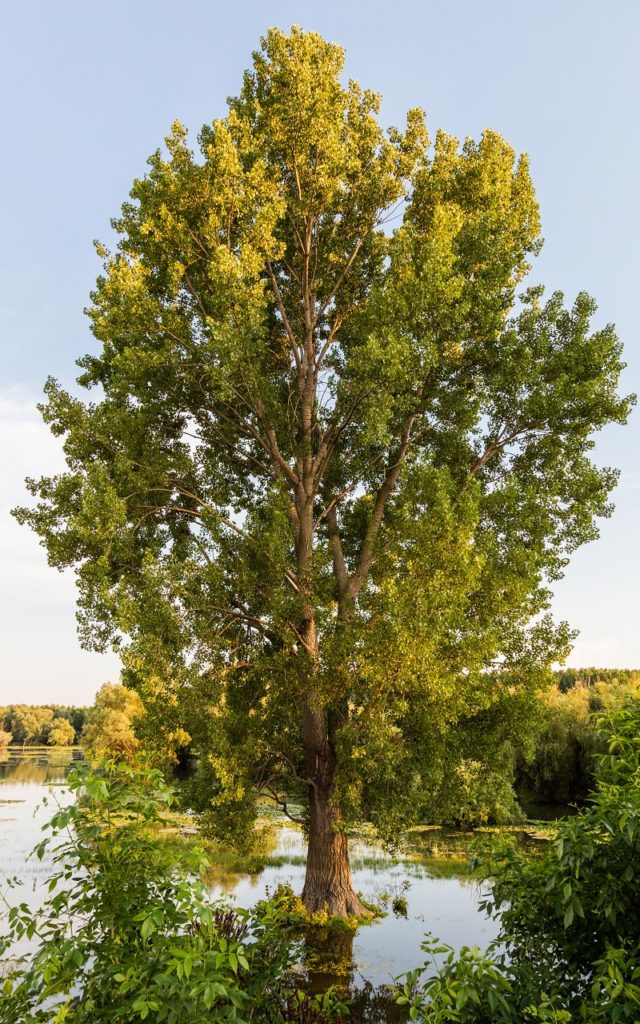
A hybrid poplar is an excellent choice if you want shade fast. It’s one of the fastest growing shade trees on our list, with a growth rate of 5 to 8 feet per year.
Beware, though: The tradeoff for such fast growth is limbs that break easily. Don’t plant a hybrid poplar where the branches hang over your roof or another structure that might be damaged.
Poplars tend to be short-lived, so keep that in mind if you’re looking for a shade tree that will last for generations. This hybrid poplar grows in a pyramid shape and turns bright yellow in fall before it drops its leaves. It lacks the cotton-like seeds of typical poplars.
- USDA Hardiness Zones: 3-9
- Growing conditions: Needs full sun. Grows well in wet alkaline or acidic soils.
- Mature size: 40- to 50-feet tall, around 30-foot spread.
- Leaf retention: Deciduous
- Flowering?: No
6. Japanese zelkova (Zelkova serrata)

The Japanese zelkova, with its peeling bark and spreading or vase-shaped crown, is an intriguing tree that does well in urban areas. Its massive spread makes it a good shade tree, and it’s drought-tolerant, which is great for Salt Lake City.
Japanese zelkovas are a good substitute for elm trees, since they aren’t susceptible to Dutch elm disease or pests like the elm leaf beetle and Japanese beetle.
- USDA Hardiness Zones: 5-8
- Growing conditions: Needs full sun. Tolerates most soil types but prefers moist loamy soils.
- Mature size: 50- to 80-feet tall, 50- to 80-foot spread.
- Leaf retention: Deciduous
- Flowering?: Yes. Blooms with tiny, inconspicuous green flowers in spring at the same time that leaves appear.
7. Kentucky coffeetree (Gymnocladus dioicus)
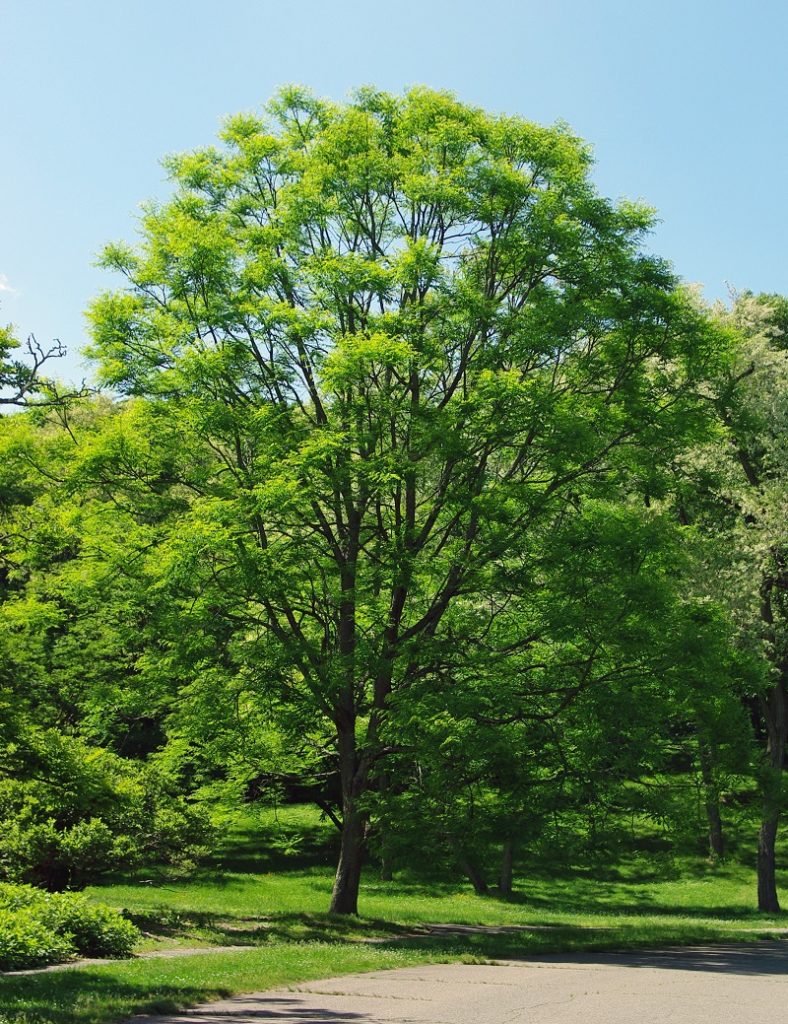
Kentucky coffeetree is another shade tree that’s perfect for Salt Lake City because it grows well through both drought and air pollution. These trees have a spreading canopy in a round or oval shape. “Female” Kentucky coffeetrees have a pleasant rose-like fragrance when in bloom.
- USDA Hardiness Zones: 3-8
- Growing conditions: Needs full sun. Grows in most soil types. Tolerates both drought and occasional flooding.
- Mature size: 60- to 75-feet tall, 40- to 50-foot spread.
- Leaf retention: Deciduous
- Flowering?: Yes. Blooms with clusters of tiny white flowers with a greenish tint that appear in May or June, after the leaves.
8. Northern catalpa (Catalpa speciosa)

Northern catalpa trees are easy to grow, and they have seasonal interest year-round. In spring, they bloom with showy white flowers, and their leaves turn a bright yellow-green in autumn before falling.
While these shade trees are easy to grow, they will require quite a bit of cleanup because they drop seed pods, leaves, and flowers. For that reason, a northern catalpa probably isn’t the best choice for shading a swimming pool or other high-traffic area where you don’t want a mess.
- USDA Hardiness Zones: 4-8
- Growing conditions: Grows well in full sun or partial shade. Tolerates most soil types. Most suited to dry soils.
- Mature size: 40- to 60-feet tall, 20- to 40-foot spread.
- Leaf retention: Deciduous
- Flowering?: Yes. Blooms in late spring or early summer with white, trumpet-shaped flowers.
9. Northern red oak (Quercus rubra)

The northern red oak is another good option for impatient homeowners who want their yard shaded sooner rather than later. This fast-growing tree can shoot up more than 2 feet per year.
The northern red oak is one of the best trees for shade because of its dense crown, and it is drought-tolerant enough for Salt Lake City summers, too. Northern red oaks have waxy leaves that turn different shades of red in fall for a classic fall color look. As oak trees, they produce acorns, so watch your step (especially if you like to walk barefoot in your yard).
- USDA Hardiness Zones: 3-8
- Growing conditions: Needs full sun. Prefers well-drained sandy, loamy, or clay soils.
- Mature size: 60- to 75-feet tall, around 45-foot spread.
- Leaf retention: Deciduous
- Flowering?: No
10. Pin oak (Quercus palustris)
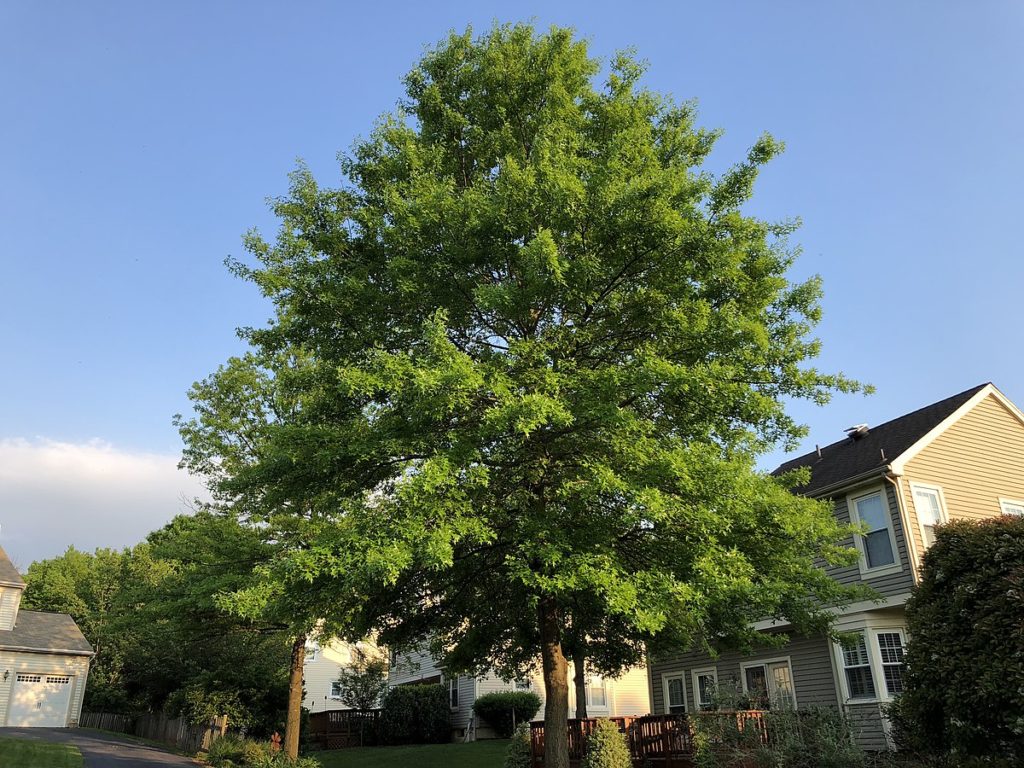
The pin oak, like its cousin the northern red oak, is a fast grower at a rate of 2 or more feet per year. Pin oaks grow in a pyramid shape that turns more oval as the tree matures, and its fall foliage is a rich bronze or red. Like other oaks, the pin oak will litter your lawn with acorns. The pin oak tolerates air pollution well, making it a good shade tree for Salt Lake City.
- USDA Hardiness Zones: 4-8
- Growing conditions: Needs full sun. Tolerates most soil types, from sandy to clay and well-drained to occasionally flooded.
- Mature size: 50- to 75-feet tall, 35- to 40-foot spread.
- Leaf retention: Deciduous
- Flowering?: No
11. Red maple (Acer rubrum)

The red maple is accurately named, since its leaves turn a vibrant red in fall, its stems turn red in winter, new leaves have a red tinge before they turn green, and it produces red flowers.
Red maple trees are good shade trees for Salt Lake City because of their wide spread and slight drought-tolerance, but be careful where you plant them. A red maple’s surface roots can damage structures and make lawn mowing difficult.
- USDA Hardiness Zones: 3-9
- Growing conditions: Grows well in full sun or partial shade. Prefers moist or wet soils that are acidic or neutral.
- Mature size: 40- to 70-feet tall, 30- to 50-foot spread
- Leaf retention: Deciduous
- Flowering?: Yes. Blooms in spring before new leaves grow with clusters of small bright red flowers.
12. Sawtooth oak (Quercus acutissima)
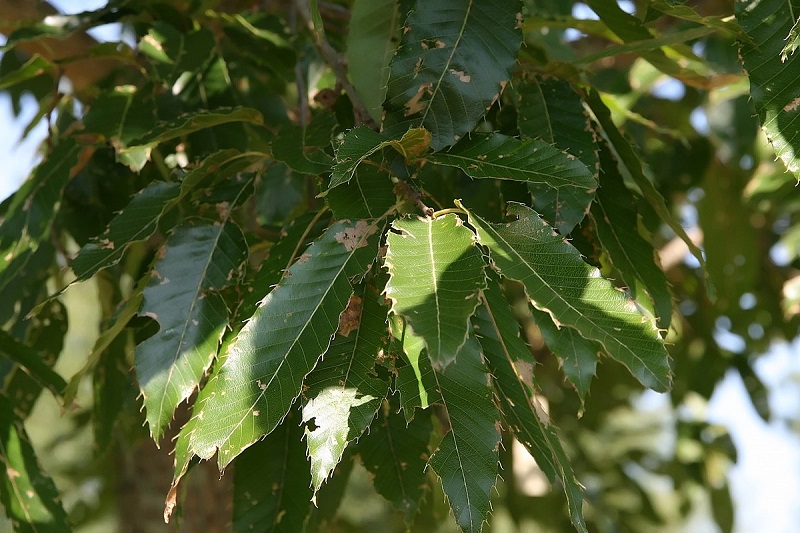
The sawtooth oak is a drought-tolerant oak that grows in a pyramid shape and gradually rounds out over time. Its dark green, glossy leaves turn different shades of yellow and gold in fall before dropping. The leaves’ serrated, toothlike edges earned the sawtooth oak its common name.
- USDA Hardiness Zones: 5-9
- Growing conditions: Needs full sun. Can tolerate most soil types as long as they aren’t too alkaline.
- Mature size: 35- to 45-feet tall, 35- to 50-foot spread.
- Leaf retention: Deciduous
- Flowering?: No
13. Thornless honeylocust (Gleditsia triacanthos var. inermis)
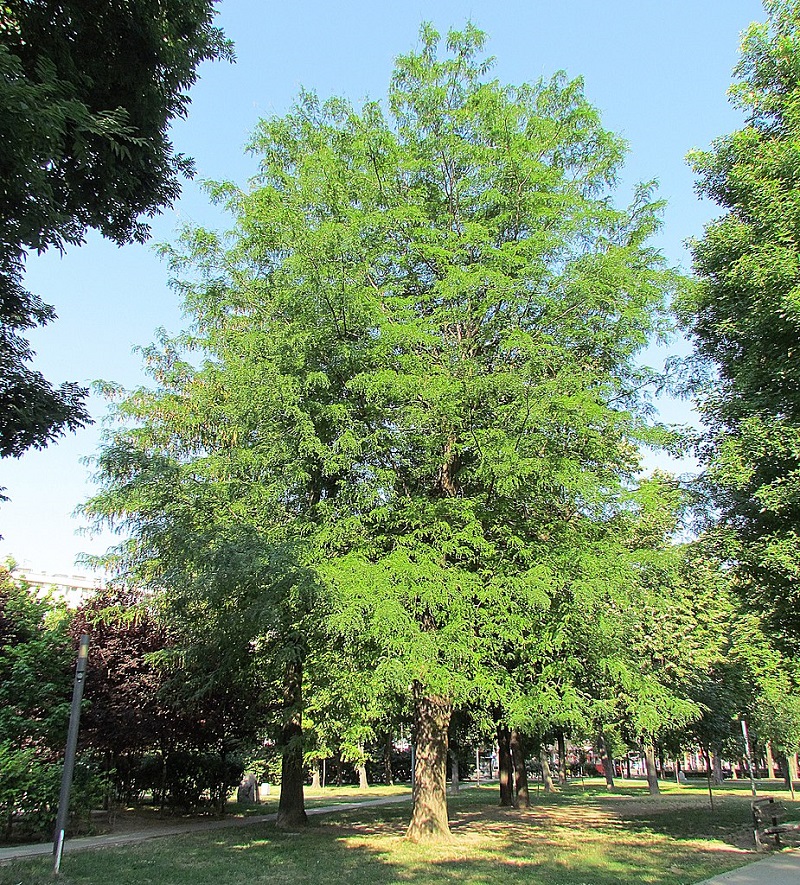
Thornless honeylocust is a fast grower with fragrant flowers. It’s special among shade trees, since you can grow grass and other shade-favoring plants beneath it. That’s because the towering thornless honeylocust has a dappled crown that lets some light filter through while still providing sufficient shade to keep you and your home cool.
As its name suggests, this honeylocust doesn’t have thorns, making it a safer choice for landscapes than other honeylocust varieties.
- USDA Hardiness Zones: 3-8
- Growing conditions: Grows well in full sun or partial shade. Grows in most soil types and tolerates both drought and flooding.
- Mature size: 50- to 75-feet tall, 35- to 50-foot spread.
- Leaf retention: Deciduous
- Flowering?: Yes. Blooms in spring with inconspicuous yellow flowers that have a strong scent.
14. Tulip tree (Liriodendron tulipifera)

The tulip tree, aka tulip poplar, aka yellow poplar, gets its name from its pretty yellow-green flowers shaped like tulips. This shade tree has a spreading, oval-shaped habit with bright green leaves that change to a showy yellow in fall. It produces a pleasant fragrance.
- USDA Hardiness Zones: 5-9
- Growing conditions: Needs full sun. Tolerates well-draining or occasionally wet clay, loam, and sandy acidic soils.
- Mature size: 80- to 100-feet tall, 30- to 50-foot spread.
- Leaf retention: Deciduous
- Flowering?: Yes. Blooms in mid-spring with yellow-green, tulip-shaped flowers.
15. Weeping willow (Salix babylonica)

The weeping willow is an infamous shade tree with sweeping branches and hanging leaves. It grows well near water, but don’t plant it too close to structures, since its roots can become invasive and cause damage.
While weeping willows will grow well in most of Salt Lake City, they might not be an option for homes in Zone 5, where winters can get cold enough to kill them.
- USDA Hardiness Zones: 6-8
- Growing conditions: Grows well in full sun or partial shade. Tolerates most soils, including poorly drained wet soils.
- Mature size: 30- to 40-feet tall, 30- to 40-foot spread
- Leaf retention: Deciduous
- Flowering?: Yes. Blooms in late spring to early summer with yellow, tube-shaped flowers on catkins.
FAQ About Shade Trees for Salt Lake City
What are the fastest growing trees for shade in Salt Lake City?
- Dawn redwood
- Hybrid poplar
- Northern red oak
- Pin oak
- Thornless honeylocust
What is the best shade tree to plant near a house in Salt Lake City?
Planting shade trees near your home can be tricky because they grow so large, with such a wide spread. Plant large trees like shade trees at least 20 feet away from your home. That will be far enough away that they will have room to grow but close enough that the tree’s shadow will cast shade on your home.
What planting zone is Salt Lake City?
Different parts of the city fall in Zones 5, 6, and 7. Check this map for your home’s specific zone.
When to Call a Professional Landscaper
If you’re still unsure which shade tree is right for your Salt Lake City yard, reach out to a local landscaping professional for help. With their expertise, local pros can help you choose the right tree for your space, soil conditions, and level of sun exposure.
A landscaper or certified arborist also can help with planting trees if you don’t know what you’re doing in that department.
Once you’ve chosen and planted your shade trees, professional landscapers also can help you maintain them. They can expertly trim and prune the branches to keep the tree growing healthy, apply pest control treatments, and remove those pesky leaves for you when fall rolls around.
When it comes to choosing shade trees for your Salt Lake City yard, don’t get too bogged down in the details. Whichever shade tree you choose for your home, the result will be the same. You’ll get an outdoor space that’s more comfortable for you and your loved ones to enjoy for years to come.
Main Photo Credit: Pixabay